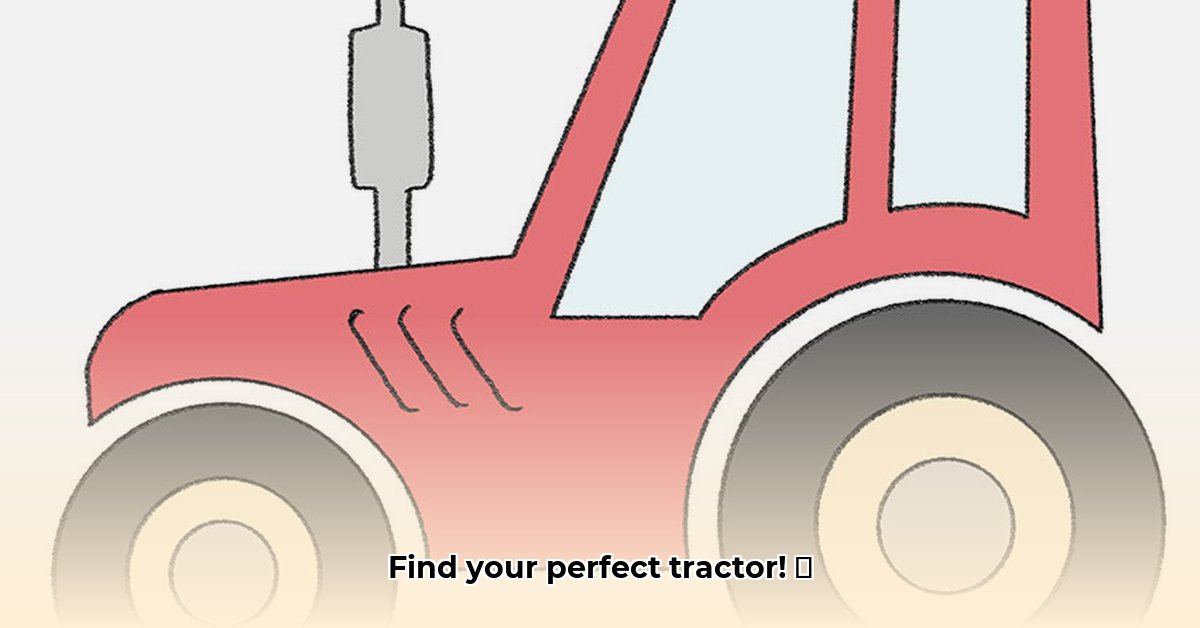
Easy Tractor: Your Guide to Finding the Perfect Fit in 2025
The quest for the perfect compact tractor can feel overwhelming. But finding the right machine for your sustainable farming operation doesn't have to be a struggle. This comprehensive guide will equip you with the knowledge to choose the best easy tractor for your needs and budget in 2025. We'll compare leading models, delve into crucial features, and provide actionable advice to help you make an informed decision. For more information on tractor pricing, check out this helpful resource: Tractor pricing guide.
Sizing Up Your Needs: Before You Even Look at Tractors
Before you get swept away by horsepower numbers, take a step back and assess your farming operation. What tasks will your tractor primarily handle? Are you working with small-scale vegetable plots demanding maneuverability, or managing larger acreage requiring more power and clearance?
Consider tasks like tilling, mowing, hauling, loader work, and even snow removal. The more detailed your assessment, the better you can match your needs to the right equipment. Budget realistically, factoring in the purchase price, ongoing maintenance, fuel costs, and potential financing. A tractor that's too powerful (and expensive) for your needs is as ineffective as one that lacks the power to handle your workload.
Top Compact Tractor Models: A Detailed Comparison
Let's examine some leading compact tractor models. Remember, these specifications are general guidelines, and you should verify them on the manufacturer's website.
| Feature | John Deere 3038E | Kioti CS2220/CX2510/DK Series | Kubota L2501 | Mahindra 1626 | Considerations |
|---|---|---|---|---|---|
| Horsepower | 38 | 22-25 | 24 | 26 | Consider your workload: more horsepower equals greater capacity for heavier tasks. |
| PTO Power (hp) | (Check Specs) | (Check Specs) | (Check Specs) | (Check Specs) | Crucial for powering implements; carefully match to your specific implement needs. |
| Lift Capacity (lbs) | (Check Specs) | (Check Specs) | (Check Specs) | (Check Specs) | Determines which implements you can operate effectively. |
| Transmission Type | (Check Specs) | HST/Gear | (Check Specs) | (Check Specs) | HST (hydrostatic) offers smoother control, while geared transmissions provide more power and precise control at speed. |
| Fuel Tank Capacity (gal) | (Check Specs) | (Check Specs) | (Check Specs) | (Check Specs) | A larger tank reduces the frequency of refueling. |
| Dimensions (LxWxH) | (Check Specs) | (Check Specs) | (Check Specs) | (Check Specs) | Essential for determining storage and maneuverability within your property. |
| Weight (lbs) | (Check Specs) | (Check Specs) | (Check Specs) | (Check Specs) | Heavier tractors generally offer better stability. |
| MSRP (Approximate) | (Check Specs) | (Check Specs) | (Check Specs) | (Check Specs) | Factor this into your overall budget, considering potential financing options. |
Important Note: Always confirm specifications with the manufacturer's current product information. Prices can fluctuate based on dealer promotions and regional differences.
Transmission Showdown: Hydrostatic vs. Geared
Choosing between hydrostatic (HST) and geared transmissions is a critical decision. HST transmissions offer infinitely variable speeds, making maneuvering in tight spaces remarkably smooth. Geared transmissions, on the other hand, offer more power and are better suited for larger, open-field operations. Your choice depends on the primary type of work your tractor will perform. Do you primarily work in confined areas, such as orchards or vineyards, or mostly in open fields?
Engine Technology and Emissions
Modern tractors are designed to meet increasingly stringent environmental regulations. Look for models meeting the latest EPA Tier emission standards. These engines are typically more fuel-efficient and environmentally friendly, leading to long-term cost and environmental benefits.
Expanding Your Reach: Implements, Implements, Implements!
The true value of your easy tractor lies in its ability to adapt through different implements. Consider essential implements like tillers, mowers, loaders, and backhoes. Your needs will dictate which implements are crucial for efficient farming. Confirm compatibility between your chosen tractor and potential implements. Your tractor must have the lift capacity and PTO power to handle your chosen attachments effectively.
The Long Game: Dealer Support and Maintenance
Choosing a reputable dealer is just as important as choosing the tractor itself. Reliable service and readily available parts are essential for minimizing downtime. Regular maintenance, including scheduled servicing and prompt repairs, significantly extends a tractor's useful life.
Your Easy Tractor Buying Guide: Step-by-Step
- Assess Your Needs: Develop a detailed list of tasks, property size, and required implements.
- Establish Your Budget: Set a realistic budget incorporating the tractor, implements, maintenance, fuel, and financing.
- Research Tractor Models: Utilize resources like this guide, comparing models based on specifications and user reviews.
- Visit Local Dealers: Test-drive models, discuss features with representatives, and assess dealer support.
- Make Your Decision: Balance your needs, budget, and long-term implications before finalizing a purchase.
Buying a compact tractor is a significant investment; careful planning is crucial for ensuring a successful and worthwhile decision. Remember, the best tractor is the one perfectly suited to your unique requirements and budget.